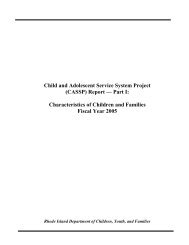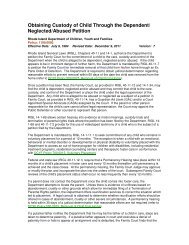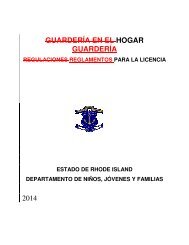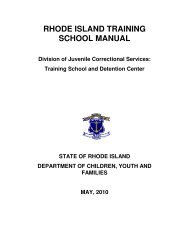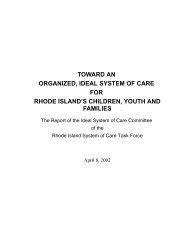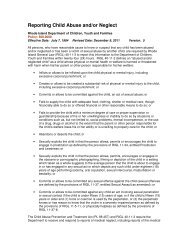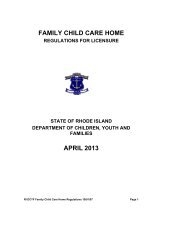Final Report - RI Department of Children, Youth & Families
Final Report - RI Department of Children, Youth & Families
Final Report - RI Department of Children, Youth & Families
You also want an ePaper? Increase the reach of your titles
YUMPU automatically turns print PDFs into web optimized ePapers that Google loves.
APPENDIX N: GENDER SPECIFIC PROGRAMMING<br />
options have not been tailored to correspond to their needs as a subgroup, and both<br />
locally and nationally there is a paucity <strong>of</strong> program options tailored to meet their unique<br />
needs. Without programming and services that are attentive to their risk pr<strong>of</strong>ile, girls and<br />
young women will continue to enter and re-enter the court system at alarming rates.<br />
The Federal Mandate to Implement Gender-specific Programming for Females<br />
In recent years, the rising numbers <strong>of</strong> girls and young women entering and re-entering the<br />
court system has stimulated national concern regarding the availability <strong>of</strong> services for<br />
females and the effectiveness <strong>of</strong> programs serving females. During the 1992<br />
Reauthorization <strong>of</strong> the Juvenile Justice and Delinquency Prevention Act <strong>of</strong> 1974,<br />
Congress paid close attention to the concerns brought by researchers and youth-serving<br />
pr<strong>of</strong>essionals in which they expressed and identified a necessity to address the genderspecific<br />
needs <strong>of</strong> girls and young women. This was accomplished through Congress’<br />
references to and emphasis on importance <strong>of</strong> equity and gender-specific services<br />
throughout the Reauthorization legislation. The final Act outlined three specific areas in<br />
which states were required to respond and take action. It required each state to:<br />
! Conduct an analysis <strong>of</strong> gender-specific services for the prevention and treatment <strong>of</strong><br />
juvenile delinquency, including the types <strong>of</strong> such services available and the need for<br />
such services for females;<br />
! Develop a plan for providing needed gender-specific services for the prevention and<br />
treatment <strong>of</strong> juvenile delinquency; and<br />
! Provide assurance that youth in the juvenile justice system are treated equitably on<br />
the basis <strong>of</strong> gender, race, family income, and mentally, emotionally, or physically<br />
handicapping conditions.<br />
These provisions recognized the Act’s previous failure to deal with gender bias in a<br />
meaningful way and provided the impetus for states to begin to look more closely at the<br />
girls and young women moving through their juvenile justice systems. Several states,<br />
including Rhode Island, have begun to proactively address these issues within their<br />
juvenile justice systems.<br />
New research and national best practices have provided a foundation <strong>of</strong> knowledge that is<br />
allowing researchers, practitioners, administrators, and policy makers to understand the<br />
utility <strong>of</strong> effective service delivery for girls in the context <strong>of</strong> goals to reduce courtinvolvement<br />
and recidivism. Research has shown that girls in the juvenile justice system<br />
are more likely than boys to be victims <strong>of</strong> abuse, to enter the system with status <strong>of</strong>fenses,<br />
and be sanctioned to programs that serve more serious, male <strong>of</strong>fenders. Since girls<br />
exhibit specific behaviors that are unique to their gender, they require different<br />
interventions, sanctions and services. The majority <strong>of</strong> juvenile justice providers<br />
nationwide lack the skills, tools, and resources necessary to be effective in providing a<br />
framework for girls to be successful in changing negative behaviors.<br />
Strengthening Services for Girls and Young Women Along the Continuum <strong>of</strong> Care<br />
The concept <strong>of</strong> gender-specific programming is grounded in sound theoretical and<br />
practical research on female development and the unique risk pr<strong>of</strong>ile shared by girls and<br />
System <strong>of</strong> Care Task Force <strong>Report</strong> (January 2003) 178





